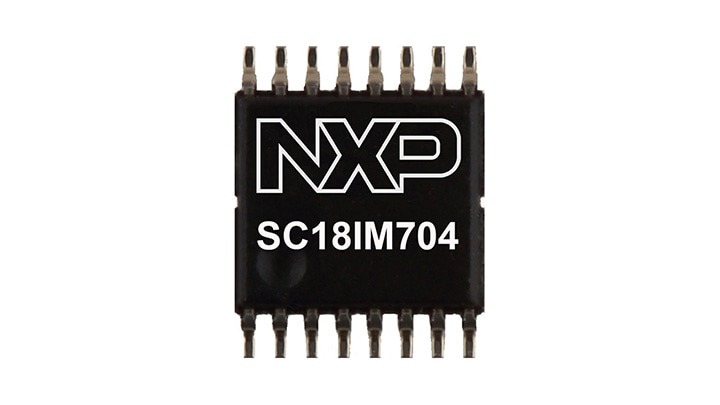
Dual UART with I²C-Bus/SPI Interface, 64 Bs of Transmit and Receive FIFOs, IrDA SIR Built-In Support
SC18IS604 is designed to serve as an interface between the standard SPI of a host (microcontroller, microprocessor, chip set, etc.) and the serial I²C-bus. This allows the host to communicate directly with other I²C-bus devices. SC18IS604 can operate as an I²C-bus controller-transmitter or controller-receiver. SC18IS604 controls all the I²C-bus specific sequences, protocol, arbitration and timing.
SC18IS604 is a functional replacement for SC18IS600 with exception of: new pinout, transmit and receive buffer of 255 bytes vs 96 bytes, three instead of four GPIOs but no longer with quasi bidirectional mode, operating supply voltage lower level lowered to 1.71 V vs 2.4 V and temperature range of -40 to 105 °C vs -40 to 85 °C.
| Part Number | UART | SPI | I²C | GPIO | Function |
| SC18IS604 | NA | 1.2 MHz | 375 kHz | 5 | SPI to I²C |
| SC18IM704 | 460.8 Kbit/s | NA | 375 kHz | 8 | UART to I²C |
| Part Number | UART | SPI | I²C | GPIO | Function |
| SC18IS606 | NA | 1.8 MHz | 400 kHz | 3 | I²C to SPI |
| Part Number | UART | SPI | I²C | GPIO | Function |
| SC16IS740/750/752 | 5 Mbit/s | 15 Mbit/s | 400 kHz | 8 | I²C/SPI to UART |

Dual UART with I²C-Bus/SPI Interface, 64 Bs of Transmit and Receive FIFOs, IrDA SIR Built-In Support

UART to I²C-Bus Bridge

Single UART with I²C-Bus/SPI Interface, 64 B of Transmit and Receive FIFOs, IrDA SIR Built-In Support

Single UART with I²C-Bus/SPI Interface, 64 Bs of Transmit and Receive FIFOs, IrDA SIR Built-In Support
|
|
|
|
|
|
|
|---|---|---|---|---|---|
|
|
|
|
|
|
|
|
|
|
|
|
|
|
|
|
|
|
|
|
|
|
|
|
|
|
|
|
|
|
|
|
|
|
|
|
|
|
|
|
|
|
|
|
|
|
|
|
|
|
|
|
|
|
|
|
|
|
|
|
|
|
|
|
|
|
|
|
|
|
Quick reference to our documentation types.
4 documents
Please wait while your secure files are loading.
Receive the full breakdown. See the product footprint and more in the eCad file.

Receive the full breakdown. See the product footprint and more in the eCad file.